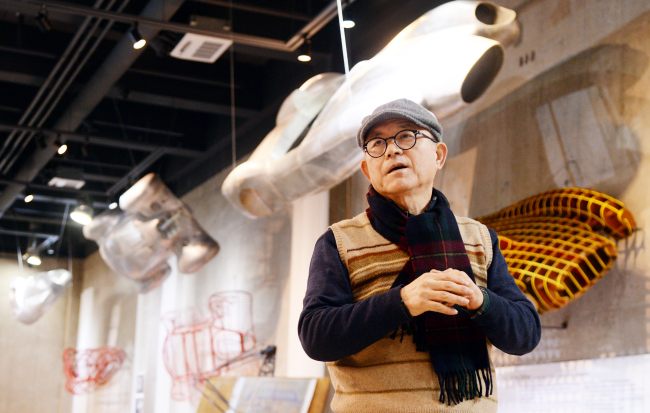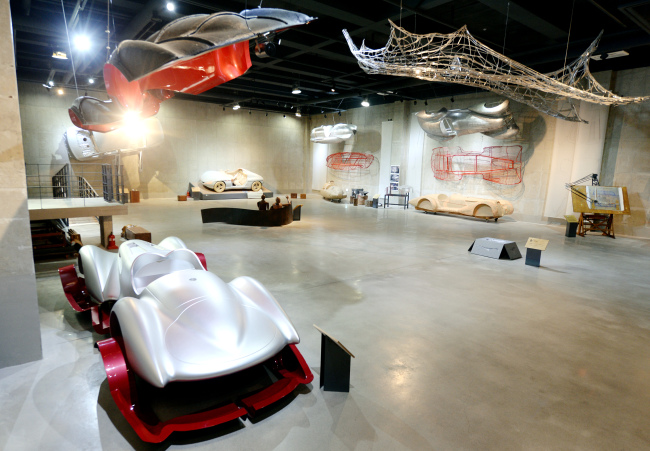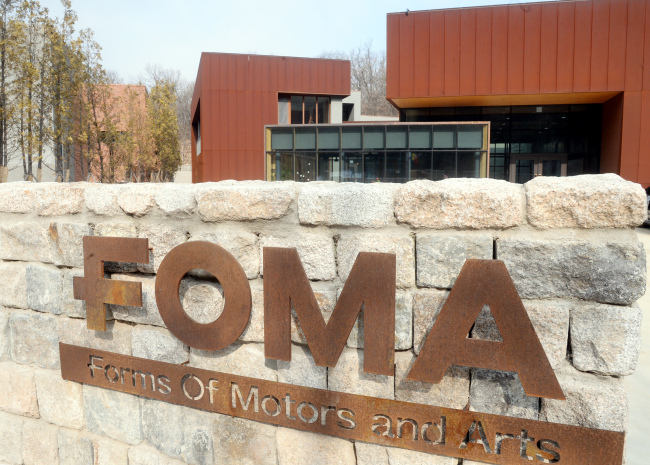[Eye] ‘Basics, nature are key to iconic auto designs’
Korea’s first car designer and creator of Hyundai’s Tiburon and Santa Fe, Park Jong-suh, reconstructs cars as a form of art, connecting the past and future of automobile design
By Korea HeraldPublished : Feb. 17, 2017 - 16:51
Park Jong-suh, 70, had never thought of becoming a car designer.
In his childhood, cars had been his favorite like other boys, though in the postwar era of the early 1950s, they often had to pretend rubber shoes were vehicles as an alternative to toy cars.
Twenty years later, Car Styling magazine in Japan would publish a set of his drawings and artwork, completely changing his life.
“I was offered to work with Hyundai Motor in 1974 when somebody in the company saw my work from the magazine. I think I was destined to work at Hyundai (as a car designer),” said Park who was then a designer at a local electronics company. “Nothing is stronger than the power of destiny.”
In his childhood, cars had been his favorite like other boys, though in the postwar era of the early 1950s, they often had to pretend rubber shoes were vehicles as an alternative to toy cars.
Twenty years later, Car Styling magazine in Japan would publish a set of his drawings and artwork, completely changing his life.
“I was offered to work with Hyundai Motor in 1974 when somebody in the company saw my work from the magazine. I think I was destined to work at Hyundai (as a car designer),” said Park who was then a designer at a local electronics company. “Nothing is stronger than the power of destiny.”

The year 1974 was one year before Hyundai Motor, then a tiny carmaker, built the first Korean-developed automobile, Pony.
The hatchback compact car opened the door for Hyundai to grow, but on the other hand, most of it was not made in Korea.
Pony originated from Hyundai Motor, now the world’s fifth-largest carmaker, but the car itself was a mere collaboration of foreign technology and funds at that time, with a design from Giorgetto Giugiaro of Italdesign, transmission and engine from Mitsubishi, machine press from France and funds from Barclays Banks.
After the launch of Pony, the mission Park faced was clear: Create the design identity and originality of the South Korean carmaker.
But there was nothing to learn about automobile design in Korea, simply because there was no such course available. Park left for the Royal College of Arts for a yearlong course -- his first proper education on car design. He was the first Korean to attend the British school.
After years of self-learning, Park’s first design, Hyundai’s Scoupe, hit the market in 1990. However, he was still unsatisfied.
“We felt so embarrassed when we had to present our works at motor shows because everyone participating in the shows were better than us,” he said. “Hyundai was not good enough to take the lead at that time. The carmaker lacked engine technology. … But design was what Hyundai could do better.”
In 1992, his concept car titled “HCD 1,” a two-seat sports vehicle with a bold design, won the best concept car award at the Detroit Motor Show. Feeling more confident, Park successfully presented Tiburon in 1996, another sports car, and the sports utility vehicle Santa Fe in 2000.
Sonata was a hit, helping Hyundai gain more presence in the global market in the 1990s.
In recognition of his contribution to South Korea’s automobile industry, he received a presidential merit in 1993 and the Brass-Tower Industry Prize in 1999.

Though Park had no predecessor in his home country in terms of auto design, nature has always been his teacher and inspiration.
The two vehicles, Tiburon and Santa Fe, famous for their bold curves and volume, were inspired by photography of masculine whales jumping from the sea of Alaska, he said.
“People today believe that they can do anything with computers. But in order to design an excellent car, you need to go back to the basic, by observing the beauty of nature and the form the nature produces.”
Park’s career as the head designer of Hyundai Motor ended in 2004, due to his health.
Shortly after his retirement, he hit the road to meet Italian artisans who create original bodies for commercial cars. The former vice president of Hyundai’s design institute said he was shocked at discovering the aesthetic curves of cars like Ferrari were created not by drawing on paper or computers, but by artisans striking hammers on metal plates for years.
“I discovered, after spending years as car designer, that the cars of excellent designs were born by sheet metal molded into the curvaceous shapes and lines of our imaginations. I wanted to let my junior designers know that even in the era of the fourth industrial revolution, which is said to be propelled by artificial intelligence, nothing can go beyond the creations of human senses,” he said.
Park’s discovery in Italy led him to open a private museum on cars and arts in Goyang, Gyeonggi Province.

A 1,300 meter-square building, named Form of Motors and Arts, or FOMA, is Park’s new studio, arts school and gallery for his collection of cars and designs inspired by the nature. In the museum, Park placed not only the Tiburon repainted in chameleonic green but also the Pony in a wooden frame.
Reproducing the car bodies is his way of rediscovering the beauty of car as an art form and proving his belief that such art forms came from nature.
“If FOMA becomes a place where young designers get inspiration and become creative, I would want nothing more,” said Park, who built the museum with $5 billion won of investment from his own pocket.
“This is also a place for children so that they can think out of box, get more creative and learn something other than what textbooks teach.”
Amid the fast evolving car industry through the development of technology, Park said car designs should become more simple and better portray the designs of nature.
“I think cars today have too much unnecessary design and functions. The era of modernism is reaching an end. Simplicity will prevail in the new world and Hyundai Motor has to understand this in order to produce iconic cars.”
Asked if he has ever given advice to Hyundai Motor’s de facto heir Chung Eui-sun, Park said he would be more than willing to, adding that the vice chairman often visits FOMA.
“He is a listener,” said Park, noting that Chung is a humble man who deliberately asks questions.
“I see Hyundai Motor’s future in him, he is ready to embrace the change.”
By Cho Chung-un (christory@heraldcorp.com)
-
Articles by Korea Herald











![[Hello India] Hyundai Motor vows to boost 'clean mobility' in India](http://res.heraldm.com/phpwas/restmb_idxmake.php?idx=644&simg=/content/image/2024/04/25/20240425050672_0.jpg&u=)








